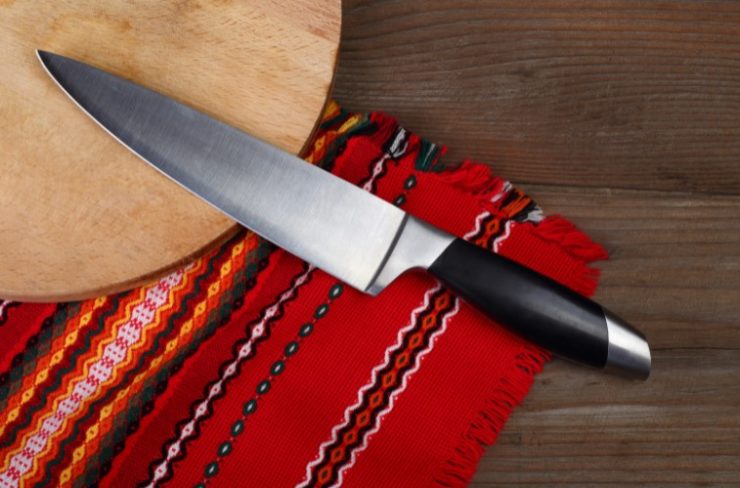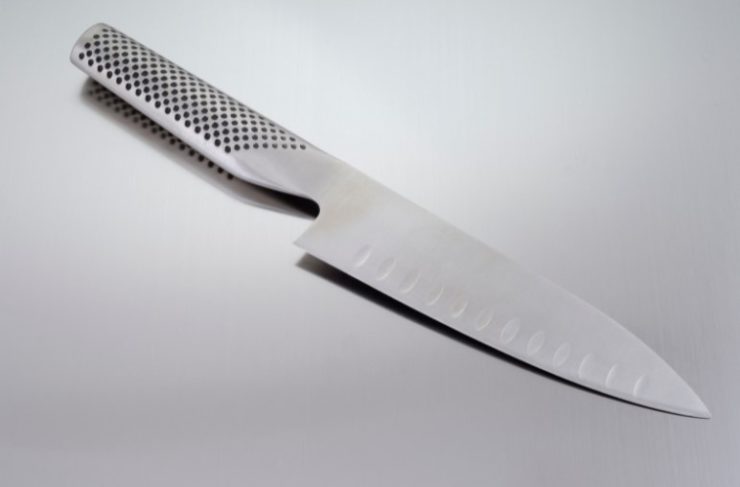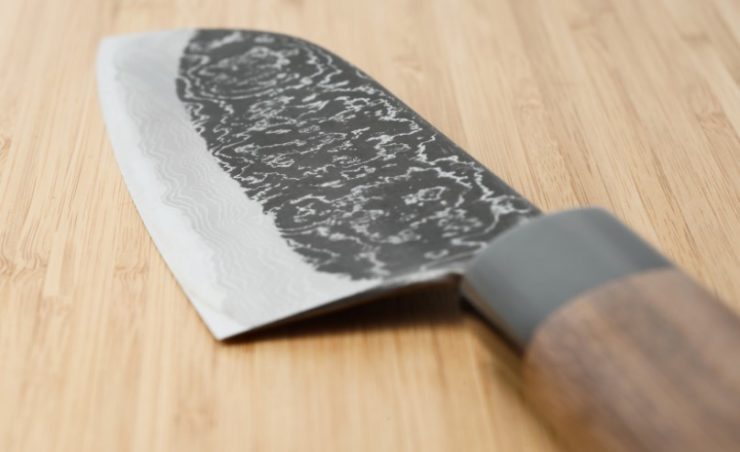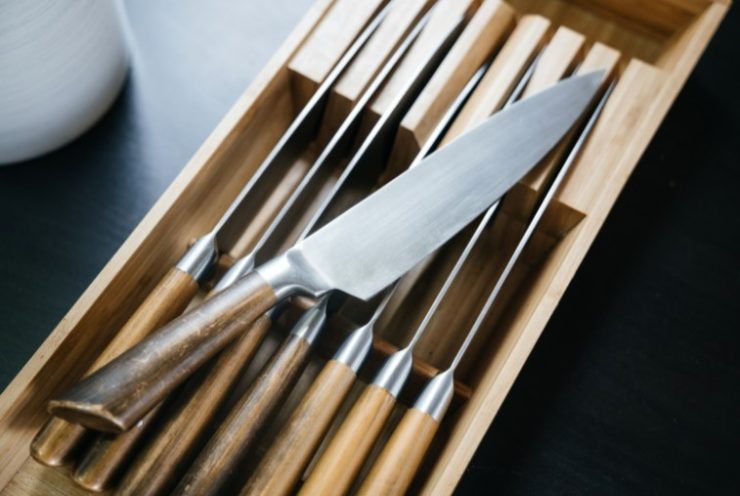Did you know that most modern knives are descended from sword making? It’s true: The same techniques used to forge blades for battle are used to create beautiful kitchen knives.
Because of that long history, it’s hard to comprehensively cover what makes the best steel for a chef’s knife. But thanks to my experience in bladesmithing and cooking, I can share a basic breakdown of what makes each steel special. Then, we’ll wrap up with a section on how to choose the right steel for your needs.
In This Article
Before We Begin: What Is the “Best”?

Every steel, from the cheapest to the most expensive, exhibits some combination of these qualities:
- Sharpness
- Hardness
- Durability
- Edge Retention
- Difficulty of Sharpening
And while it’s nice to imagine a steel that has the best of all those qualities, it doesn’t quite work that way. Every steel is a tradeoff of these attributes.
For example: A knife that is exceptionally hard and sharp will also be more difficult to sharpen. Conversely, a knife that is made of softer steel might have better edge retention and be easier to sharpen.
So is there one “best” steel for a chef’s knife? In my experience, no. There are only steels that are appropriate to a chef’s skill level — and their willingness to sharpen and care for their own knives.
On Metallurgy and Marketing
The best advice I ever received on buying a knife was this, from a chef friend:
Metallurgy is complicated. Marketing isn’t.
What she meant by this is that the art and science of knife making is hard to define. It takes real skill, practice, and understanding to produce a quality blade from any material.
But at the same time, marketers use the language of metallurgy and knife making to sell products. Often this means taking something out of its original context to make it sound better.
The message: Be wary of claims made by anyone who’s selling a knife. And don’t concern yourself as much with the “best sounding” metal as whether the blade suits your purposes.
With that in mind, let’s move on to the three main categories of steel used for chef’s knives.
The Types of Steel Used for Kitchen Knives
To understand knives, first consider that steel is an alloy. This means that it is a combination of iron, carbon, and other trace elements. And the combination of those fine particulates is what differentiates one type of steel from another.
All said and done, there are hundreds of proprietary steels made by dedicated steel manufacturers. But broadly speaking, all of the steels used for chef’s knives fit into one of these three categories.
Tool Steel

The least expensive kitchen knives on the market are commonly made from tool steel. Eight different grades of tool steel are used in cutlery, with a varying range of stain resistance.
Chances are good you’ve never heard of a tool steel chef’s knife. Because it’s not held in high regard as a material for kitchen knives, blades made from tool steel are usually not advertised as such.
Many stamped kitchen knives are made of tool steel, as it is inexpensive and easy to die cut. The “semi-stainless” D2 grade tool steel is a popular choice, as its higher carbon and chromium content help prevent rust and discoloration.
A chef’s knife made from tool steel is an okay choice for any home cook on a very tight budget. But for almost the same price, you can find knives made with steel that are better for use in the kitchen. For example: Mercer Culinary’s Millennia series chef’s knife sells for under $20 and is made with a Japanese stainless steel blade.
What we like
- Inexpensive
- Widely available
What We don’t
- Many types of tool steel aren’t stain resistant
- Generally produces the lowest quality knives
Stainless Steel

Stainless steel is far and away the most commonly used metal for the blades of chef’s knives. That’s due to a combination of affordability and the wide variety of proprietary stainless steels offered by manufacturers.
Despite its name, stainless steel is not completely impervious to rust and staining. Instead, it’s a distinction made based on a steel’s resistance to staining.
What makes stainless steel resistant to corrosion? The inclusion of chromium as a main part of the steel’s alloy. To be called stainless steel, a knife must include at least 10.5% chromium content by weight.
Modern stainless steels may also include a variety of other metals, such as cobalt, molybdenum, and vanadium. Each of these metals changes the blade’s basic characteristics — but it’s not as simple as listing out the qualities of each metal.
Why? Because the knife maker’s forging process is just as important as the specific alloy used. Traditional forging methods can make a good knife out of inferior steel, and poor production methods can ruin otherwise good metal.
This means that you can’t take a stainless steel chef’s knife at face value. There’s a huge difference in stainless steels from any two knife makers. And this is reflected in the wide range of prices for stainless steel chef’s knives.
As an example, consider two stainless steel chef’s knives:
- Mueller’s Stainless Steel Chef’s Knife, a blade that runs about $10 and is made of stamped stainless steel with a plastic handle.
- The Miyabi Stainless Steel Japanese Chef’s Knife, a nearly $300 work of art with a natural birchwood handle.
Both of these knives are technically made of stainless steel. But as I’m sure you can imagine, everything else about them is wildly different. Their sharpness, durability, and edge retention are in two totally different leagues.
What we like
- Widest range of prices and qualities
- Good corrosion resistance
What We don’t
- Variable quality makes it hard to determine which knives are worth buying
- The term “stainless steel knife” isn’t an indicator of quality
Carbon Steel

High-carbon steel was once the metal of choice for swordsmiths. Now, a carbon steel knife is still the tool of choice for many professional chefs.
But what is carbon steel? Against expectations, the metal classed as “carbon steel” actually has less carbon content than typical stainless steel. Strange, right?
The difference is in how well mixed the carbon is within the alloy. In carbon steel knives, the exact type of carbon molecules is different — allowing it to create a more homogenous mixture in the final steel.
As a result, carbon steel knives are often harder and sharper than stainless steel knives. The tradeoff here is in brittleness and edge retention. True carbon steel chef’s knives are impressively sharp, but vulnerable to chipping if used improperly.
And as you might expect, most of this type of steel does not have high corrosion resistance. It requires regular oiling with mineral oil to prevent rusting and discoloration.
With all this considered, high carbon steel is still the blade material of choice for many chefs. A knife like the Yoshihiro Mizu Yaki Blue High Carbon Steel chef’s knife becomes a prized possession thanks to its excellent performance. It requires more maintenance, but the tradeoff is worth it for chefs who want to work with the sharpest knives possible.
What we like
- Capable of making the sharpest knives
- Material of choice for traditional knife makers
What We don’t
- The tradeoff for sharpness is edge brittleness and lack of corrosion resistance
- Often expensive
How to Choose the Right Steel for Your Chef’s Knife
With all of that in mind, how are you supposed to find the right chef’s knife for your kitchen? I recommend balancing three things:
- Your budget
- Your experience level
- Your desire to learn
Let me break that down in practical terms.
A beginner who only wants to use a knife for casual cooking will do just fine with an inexpensive knife. A basic stainless steel chef’s knife in the $20-$50 range will work well.
But what if that same cook wants to practice their knife skills and really up their game in the kitchen? Investing more in a better knife will have greater long-term returns in enjoyment and skill. Consider buying a stainless steel knife from a respected supplier like Wusthof or Shun.
And if you’re already an experienced cook, you know there’s no end to the things you can learn in the kitchen. In an ideal world, you’ll have the budget for a hand-forged carbon steel knife. Then, you’ll buy a few whetstones to sharpen your own knives with.
So in the end, just as each chef is different, so should their choice of knife be different as well. Get to know your own cooking style and study up on different knife brands and you’ll be able to find the right knife for you.







